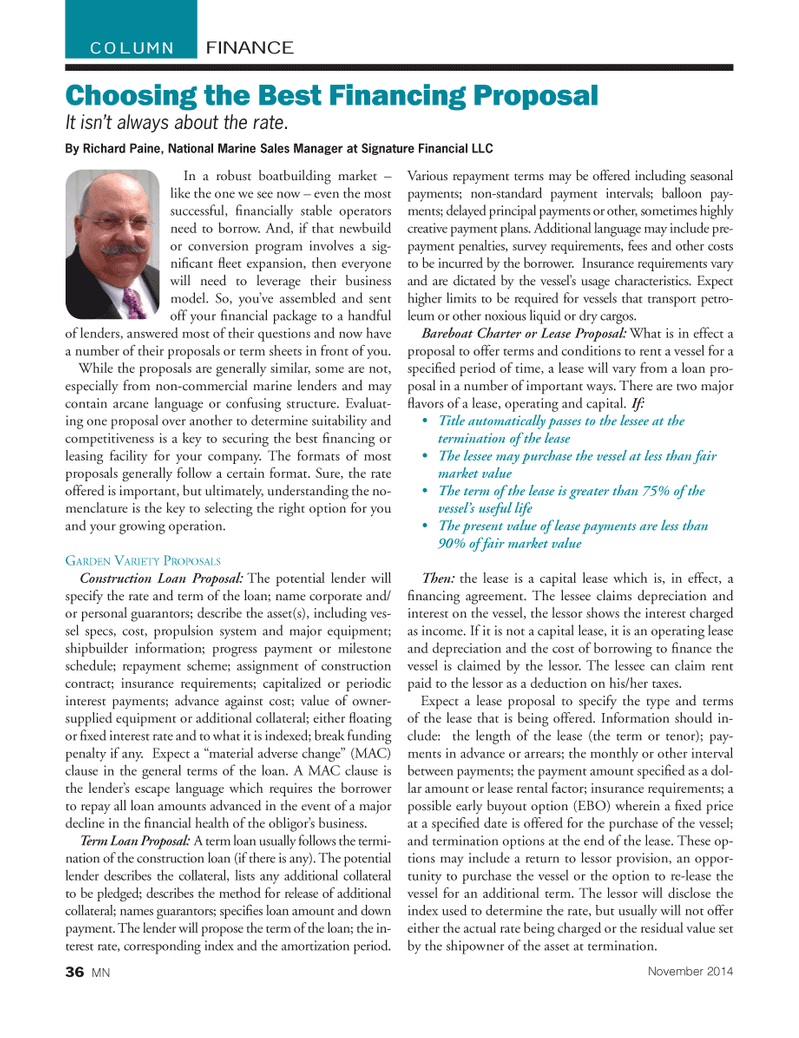
Page 36: of Marine News Magazine (November 2014)
Workboat Annual
Read this page in Pdf, Flash or Html5 edition of November 2014 Marine News Magazine
In a robust boatbuilding market – like the one we see now – even the most successful, fi nancially stable operators need to borrow. And, if that newbuild or conversion program involves a sig- nifi cant fl eet expansion, then everyone will need to leverage their business model. So, you’ve assembled and sent off your fi nancial package to a handful of lenders, answered most of their questions and now have a number of their proposals or term sheets in front of you.
While the proposals are generally similar, some are not, especially from non-commercial marine lenders and may contain arcane language or confusing structure. Evaluat- ing one proposal over another to determine suitability and competitiveness is a key to securing the best fi nancing or leasing facility for your company. The formats of most proposals generally follow a certain format. Sure, the rate offered is important, but ultimately, understanding the no- menclature is the key to selecting the right option for you and your growing operation.
GARDEN VARIETY PROPOSALS
Construction Loan Proposal: The potential lender will specify the rate and term of the loan; name corporate and/ or personal guarantors; describe the asset(s), including ves- sel specs, cost, propulsion system and major equipment; shipbuilder information; progress payment or milestone schedule; repayment scheme; assignment of construction contract; insurance requirements; capitalized or periodic interest payments; advance against cost; value of owner- supplied equipment or additional collateral; either fl oating or fi xed interest rate and to what it is indexed; break funding penalty if any. Expect a “material adverse change” (MAC) clause in the general terms of the loan. A MAC clause is the lender’s escape language which requires the borrower to repay all loan amounts advanced in the event of a major decline in the fi nancial health of the obligor’s business.
Term Loan Proposal: A term loan usually follows the termi- nation of the construction loan (if there is any). The potential lender describes the collateral, lists any additional collateral to be pledged; describes the method for release of additional collateral; names guarantors; specifi es loan amount and down payment. The lender will propose the term of the loan; the in- terest rate, corresponding index and the amortization period.
Various repayment terms may be offered including seasonal payments; non-standard payment intervals; balloon pay- ments; delayed principal payments or other, sometimes highly creative payment plans. Additional language may include pre- payment penalties, survey requirements, fees and other costs to be incurred by the borrower. Insurance requirements vary and are dictated by the vessel’s usage characteristics. Expect higher limits to be required for vessels that transport petro- leum or other noxious liquid or dry cargos.
Bareboat Charter or Lease Proposal: What is in effect a proposal to offer terms and conditions to rent a vessel for a specifi ed period of time, a lease will vary from a loan pro- posal in a number of important ways. There are two major fl avors of a lease, operating and capital. If: Title automatically passes to the lessee at the termination of the lease The lessee may purchase the vessel at less than fair market value The term of the lease is greater than 75% of the vessel’s useful life The present value of lease payments are less than 90% of fair market value
Then: the lease is a capital lease which is, in effect, a fi nancing agreement. The lessee claims depreciation and interest on the vessel, the lessor shows the interest charged as income. If it is not a capital lease, it is an operating lease and depreciation and the cost of borrowing to fi nance the vessel is claimed by the lessor. The lessee can claim rent paid to the lessor as a deduction on his/her taxes.
Expect a lease proposal to specify the type and terms of the lease that is being offered. Information should in- clude: the length of the lease (the term or tenor); pay- ments in advance or arrears; the monthly or other interval between payments; the payment amount specifi ed as a dol- lar amount or lease rental factor; insurance requirements; a possible early buyout option (EBO) wherein a fi xed price at a specifi ed date is offered for the purchase of the vessel; and termination options at the end of the lease. These op- tions may include a return to lessor provision, an oppor- tunity to purchase the vessel or the option to re-lease the vessel for an additional term. The lessor will disclose the index used to determine the rate, but usually will not offer either the actual rate being charged or the residual value set by the shipowner of the asset at termination.
FINANCECOLUMN
Choosing the Best Financing Proposal
It isn’t always about the rate.
By Richard Paine, National Marine Sales Manager at Signature Financial LLC
November 2014 36 MN
MN Nov14 Layout 32-49.indd 36 10/23/2014 10:26:10 AM

 35
35

 37
37
